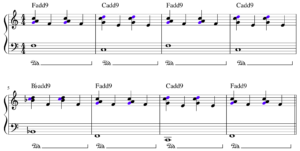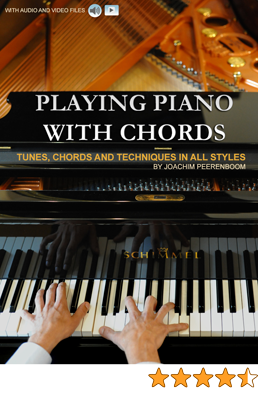The previous post contained the first three steps to create a ballad style piano piece:
-
creating a chord progression
-
using inversions for a better voice leading
-
and adding the bass notes in the left hand
Adding sweetness to the sound
Now let’s move on and take it from there. A great way to make the sound of the pop ballad progression sweeter and more colorful is to add the ninth (or second) to each chord.
You can find the ninth (or second – they are actually the same note) simply by moving up one whole step (or two half steps) from the root of each chord. So for F major the ninth is G, for C major the ninth is D and for Bb major it is C.
Here is the chord progression we used before, but this time with the added ninths (marked in blue). You will note the different sound right away!

Looking for more ballad piano chords?
Changing the rhythm
Instead of playing the chords as whole notes, which are held for four beats, you can apply different rhythmic patterns to make them sound more interesting.
Here is an example using quarter notes instead of whole notes. It’s very simple: on beats 1 and 3 you play the upper three notes of each chord and on beats 2 and 4 you play the lowest note. This will result in a very common rhythmic pattern, that you can apply to other songs or chord progressions as well. The bass note in the left hand is held for all four beats or the whole bar. Using the pedal adds more depth to the sound of this pop ballad progression.

In the next post you will learn another rhythmic pattern and a way to combine patterns to create your own version of any chord progression.



